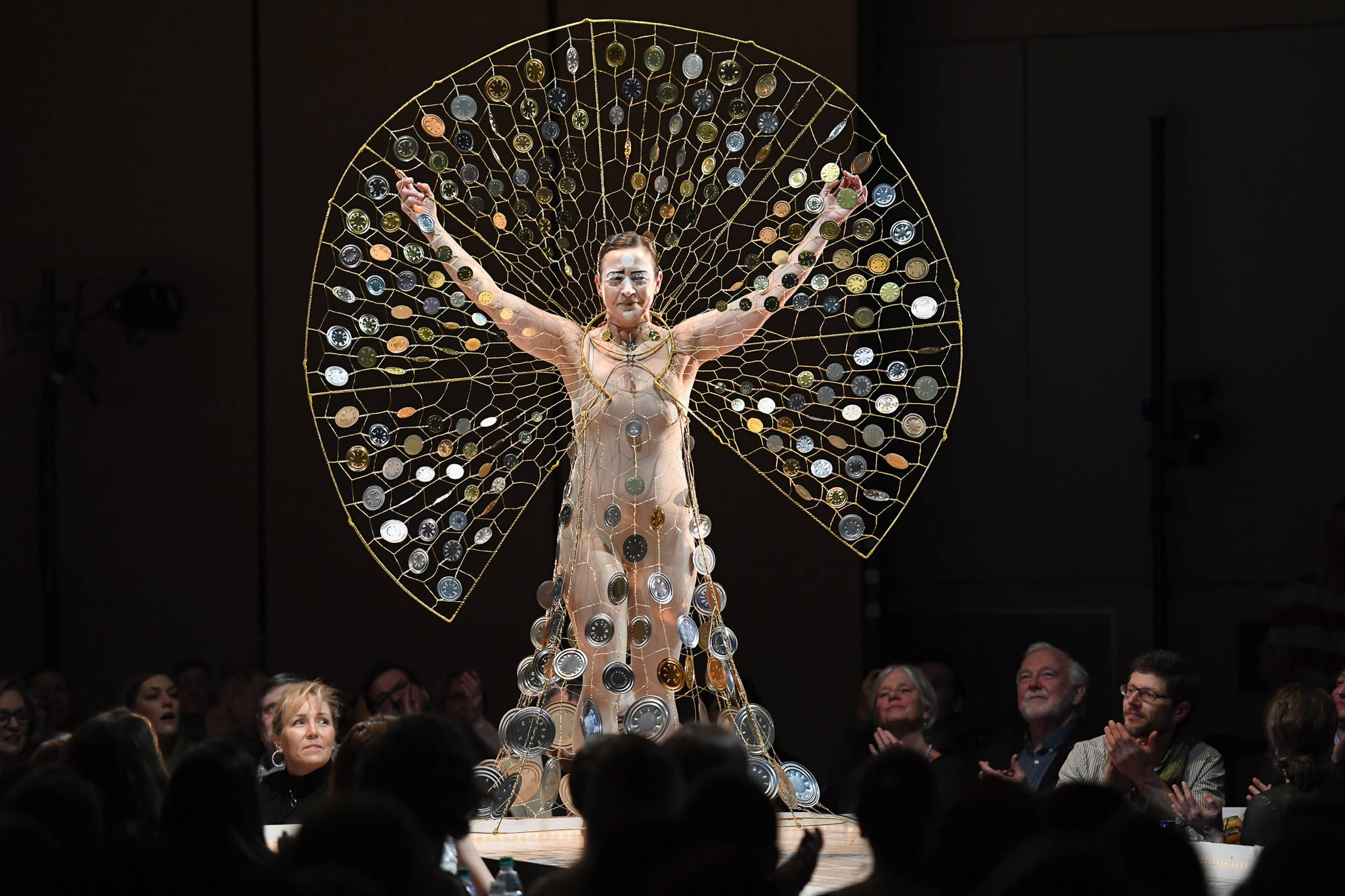The Juneau Arts & Humanities Council has announced the winners of the 2019 Wearable Art Extravaganza: Tailwind.
The four-judge panel awarded first place to Wishes & Prayers in Turbulent Times (entry No. 14) by Rhonda Jenkins Gardinier. Second place went to Flipping Out (entry No. 25) by Michelle Morris, and the third spot was won by Calm in the Wild (entry No. 3) by Jessica Sullivan.
[PHOTOS: See photos of all the entries in our slideshow]
There were some early favorites that drew big responses from a packed Centennial Hall on Saturday.
“T-60” a piece made and modeled by Morgan McCutcheon based on armor from the “Fallout” video game series was an early favorite that won the People’s Choice Award. Members of the Wearable Art audiences at both the Saturday and Sunday shows received a token to allow them to vote for their favorite entry. According to a press release, the most audience votes were cast for T-60, followed by Wishes & Prayers in Turbulent Times, Flipping Out, and Karen Smith & Olivia Moore’s Plastic Resuscitation (entry No. 4).
“A lot of work and construction went into (“T-60”),” said Angela Ecklund, a wowed audience member and past Wearable Art artist.
The hulking ensemble weighed in at 70 pounds, and after the show McCutcheon said it took about two years to make. This was the third Wearable Art showing for McCutcheon, who said the piece was made with both cosplaying — a portmanteau of costume and playing that describes often elaborate costumes often seen at conventions — and the annual fashion event in mind.
McCutcheon said it was “really hot and heavy” inside “T-60.”
“Dea Pluviam” was a piece that also went to great distances. It was made with hundreds of feet of plastic wrap, which worked out to be about three and a half Cost Co boxes of the stuff, said artist Savannah Maidy.
The piece also made use of recycled copper wire and LED lights. Lights were a major part of many of the night’s pieces.
Wire was less prevalent, but it did figure into the night’s first place winner “Wishes & Prayers in Turbulent Times.”
The piece’s title referenced Wearable Art 2o19’s previous theme, Turbulence. The name was changed to Tailwind by organizers with input from Alaska Airlines, a major event sponsor, which noted the word has a negative connotation when related to flight.
Jenkins Gardinier’s piece made use of wire, wire hangers, tin can ends and fishing swivels, and moved in surprising ways while she made her way down a tarmac-themed runway.
“I love tin cans because it’s a beautiful material we throw away every day,” Jenkins Gardinier said after the show.
The tin can ends in the ensemble had words punched on them, “like a prayer wheel idea,” Jenkins Gardinier said.
Recycled and repurposed materials were a prevalent theme throughout the 27 entries in this year’s fashion show.
“Plastic Resurrection” by artists Karen Smith and Olivia Moore, which was modeled by Moore, made use of every part of discarded Alaska Airlines Plastic cups. “Kith and Kin” by artists Peggy Corazza and Alicia Harris used recycled rabies tags and dog licenses.
“Runner’s High” a piece made and modeled by young artists Ella Sowell and Amelia Walker featured repurposed race bibs and T-shirts compiled over the past 10 years.
It was the first time ether had shown work during Wearable Art.
“It was pretty good,” Walker said. I kind of liked it, but I was nervous at first.”
Honorable mentions
The four judges for this year’s Wearable Art were Melissa Griffiths, Patricia Hull, Gigi Monroe and Pua Maunu, and each was allowed to select a piece for Honorable Mention.
Griffiths chose Kith and Kin (entry No. 13) by Peggy Corazza and Alicia Harris; Hull honored Sylph (entry No. 24) by Kathleen Harper and Anne Szeliski; Monroe named T-60, and Maunu selected The Siren (entry No. 23) by Clare Boily and Hal Turman.
Next year JAHC will celebrate 20 years with the Wearable Art Extravaganza: Joie de Vivre. The French phrase is typically used to describe someone with an enjoyment of life.
• Contact reporter Mollie Barnes at mbarnes@juneauempire.com or 523-2228.

